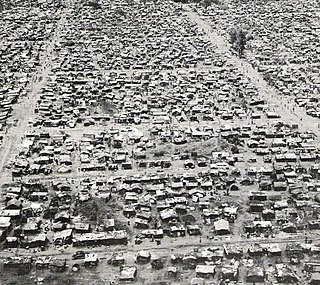Related Research Articles

South West Africa was a territory under South African administration from 1915 to 1966, and under South African occupation from 1966 to 1990. Renamed Namibia by the United Nations in 1968, it became independent under this name on 21 March 1990.
The history of Namibia has passed through several distinct stages from being colonised in the late nineteenth century to Namibia's independence on 21 March 1990.

The Japanese Peace Bell is a bell donated to the United Nations Headquarters in New York City via the United Nations Association of Japan in June 1954. It is a bonsho that is 60 centimeters in diameter, 1 meter in height, and 116 kg (256 lb) in weight. It was established by Chiyoji Nakagawa.
China is one of the members of the United Nations and is one of five permanent members of its Security Council. One of the victorious Allies of World War II, the Republic of China (ROC) joined the UN as one of its founding member countries in 1945. The subsequent resumption of the Chinese Civil War between the government of Republic of China and the rebel forces of the Chinese Communist Party, led to the latter's victory on the mainland and the establishment of the People's Republic of China (PRC) in 1949. Nearly all of mainland China was soon under its control and the ROC government retreated to the island of Taiwan.

The history of the United Nations has its origins in World War II beginning with the Declaration of St James's Palace. Taking up the Wilsonian mantle in 1944–1945, US President Franklin D. Roosevelt pushed as his highest postwar priority the establishment of the United Nations to replace the defunct League of Nations. Roosevelt planned that it would be controlled by the United States, Soviet Union, United Kingdom and China. He expected this Big Four would resolve all major world problems at the powerful Security Council. However the UN was largely paralyzed by the veto of the Soviet Union when dealing with Cold War issues from 1947 to 1989. Since then its aims and activities have expanded to make it the archetypal international body in the early 21st century.

The Congo Crisis was a period of political upheaval and conflict between 1960 and 1965 in the Republic of the Congo. The crisis began almost immediately after the Congo became independent from Belgium and ended, unofficially, with the entire country under the rule of Joseph-Désiré Mobutu. Constituting a series of civil wars, the Congo Crisis was also a proxy conflict in the Cold War, in which the Soviet Union and the United States supported opposing factions. Around 100,000 people are believed to have been killed during the crisis.

The School of International and Public Affairs (SIPA) is the international affairs and public policy school of Columbia University, a private Ivy League university located in Morningside Heights, Manhattan, New York City. SIPA offers Master of International Affairs (MIA) and Master of Public Administration (MPA) degrees in a range of fields, as well as the Executive MPA and PhD program in Sustainable Development.

Jaja Anucha Ndubuisi Wachuku was a Pan-Africanist and a Nigerian statesman, lawyer, politician, diplomat and humanitarian. He was the first Speaker of the Nigerian House of Representatives; as well as the first Nigerian Ambassador and Permanent Representative to the United Nations. Also, Wachuku was the first Nigerian Minister for Foreign Affairs. Notably, Wachuku was a Royal Prince of Ngwaland, "descendant of 20 generations of African chiefs in the Igbo country of Eastern Nigeria".
The Agreement among the People's Republic of Angola, the Republic of Cuba, and the Republic of South Africa granted independence to Namibia from South Africa and ended the direct involvement of foreign troops in the Angolan Civil War. The accords were signed on 22 December 1988 at the United Nations Headquarters in New York City by the Foreign Ministers of People's Republic of Angola, Republic of Cuba and Republic of South Africa.
In the 1980s in Angola, fighting spread outward from the southeast, where most of the fighting had taken place in the 1970s, as the African National Congress (ANC) and SWAPO increased their activity. The South African government responded by sending troops back into Angola, intervening in the war from 1981 to 1987, prompting the Soviet Union to deliver massive amounts of military aid from 1981 to 1986. The USSR gave the Angolan government over US$2 billion in aid in 1984. In 1981, newly elected United States President Ronald Reagan's U.S. assistant secretary of state for African affairs, Chester Crocker, developed a linkage policy, tying Namibian independence to Cuban withdrawal and peace in Angola.

Relations between Angola and South Africa in the post-apartheid era are quite strong as the ruling parties in both states, the African National Congress in South Africa and the MPLA in Angola, fought together during the Angolan Civil War and South African Border War. They fought against UNITA rebels, based in Angola, and the apartheid-era government in South Africa which supported them. Nelson Mandela mediated between the MPLA and UNITA during the final years of the Angolan Civil War. Although South Africa was preponderant in terms of relative capabilities during the late twentieth century, the recent growth of Angola has led to a more balanced relation.
In the 1990s in Angola, the last decade of the Angolan Civil War (1975–2002), the Angolan government transitioned from a nominally communist state to a nominally democratic one, a move made possible by political changes abroad and military victories at home. Namibia's declaration of independence, internationally recognized on April 1, eliminated the southwestern front of combat as South African forces withdrew to the east. The MPLA abolished the one-party system in June and rejected Marxist-Leninism at the MPLA's third Congress in December, formally changing the party's name from the MPLA-PT to the MPLA. The National Assembly passed law 12/91 in May 1991, coinciding with the withdrawal of the last Cuban troops, defining Angola as a "democratic state based on the rule of law" with a multi-party system.

The Permanent Mission of France to the United Nations is the diplomatic mission of the French Republic to the United Nations in New York. As such, it reports to the Ministry of Foreign and European Affairs.
The Burundian Permanent Representative to the United Nations in New York is the official representative of the Government of Burundi to the Headquarters of the United Nations.
The Permanent Representative of Jordan to the United Nations is the representative of the government in Amman, Jordan, to the Headquarters of the United Nations in New York City.

The Permanent Mission of India to the United Nations is the formal title of the Indian delegation to the United Nations (UN). India was among the founding members of the United Nations and signed the Declaration by United Nations on 1 January 1942. India also participated in the United Nations Conference on International Organization and Diwan Bahadur Sir Arcot Ramasamy Mudaliar signed the United Nations Charter on India's behalf.
The 1973 United Nations International Convention on the Suppression and Punishment of the Crime of Apartheid was the first binding international treaty which declared the crime of apartheid and racial segregation under international law. It was adopted by the General Assembly on 30 November 1973 and came into force on 18 July 1976. It passed by 91 votes in favor, four against and 26 abstentions. 110 countries are currently parties to the convention, with 26 signatories.

Namibia–Turkey relations are the bilateral relations between Namibia and Turkey. Turkey has an embassy in Windhoek since January 4, 2012.
The Church Center for the United Nations is a private building founded, owned, and operated by the United Methodist Church as an interfaith space housing the offices of various religions as well as several non-governmental organizations. It is at 777 United Nations Plaza in New York City, across the street from, but not part of, the United Nations Headquarters complex.

The Permanent Mission of Armenia to the United Nations is the diplomatic mission of Armenia to the United Nations. The Mission in New York serves as one of three permanent representations of Armenia to the United Nations, with the other two being based in Vienna and Geneva.
References
- ↑ South Africa New York
- ↑ Eric Louw
- ↑ David Whitefoord Steward
- ↑ Josiah Khiphusizi Jele
- ↑ Kingsley Mamabolo
- ↑ Standard Encyclopaedia of Southern Africa, Capetown, Volume 4. 1971. ISBN 9780625003204 . Retrieved 15 August 2017.